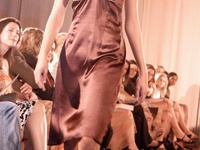
An über-stern model showcases a Lewis Albert Remele ‘06 dress during an October 2005 fashion show at Chateau Veronique in Brookline, Mass.
NEW YORK—Not far from the seventy-five sons of Harvard munching on soft-shell crab in the Grill Room, up two flights of crimson-carpeted stairs, past the mounted moose heads, beyond the Library and the conspicuously displayed copies of the Harvard Gazette, lies the Mahogany Room, where daughters and granddaughters of those soft-shell crab-munching sons of Harvard pawed and prodded at frocks hawked by one Lewis Albert.
Over a lunch hour last week here in New York City, I decided to stop in at the Harvard Club to take in the trunk show of Harvard’s hottest fashion designer.
“Oh that looks really nice on you,” cooed Lewis Albert Remele ’06, the fledgling designer whose label’s traveling trunk show circus was making its sixth and final stop of the summer.
A pretty, young blonde tried on an Atlantic blue satin cocktail dress—dreamily named Style #101—with Remele’s assistance.
Conceived in Quincy House by Remele and his friend Elizabeth R. Whitman ’06, Lewis Albert is now selling its Fall 2006 collection which debuted at February’s Fashion Week before the presumably sunglass-ed eyes of the omnipotent Vogue editor Anna Wintour.
“What’s nice about our clothes is they are really feminine but nothing about them screams sex,” the blue-eyed Remele said.
Although without a permanent home for his collection, Remele hopes that his cocktail dresses ($500–$800), evening gowns ($1,000–$2,200), and cashmere coats ($1,400–$2,600) will arrive in fifteen boutiques throughout the country by next spring.
A potential buyer hovered, combed through the clothes, and asked Remele where he went to school.
“Harvard,” he chirped.
“Oh.” The buyer deflated. “I thought you went to Parsons.” (Remele did, in fact, take classes at the Parsons School of Design in New York.)
Unfortunately, there are some industries where the H-Bomb remains a dud.
Apologizing for the empty room, the designer said that over 100 people passed through the previous night—and not all were undergrads or recent graduates.
“I would say, we’ve got a nice base of younger girls who are wearing our clothes in their twenties. You know, girls who dress up and want to be a little more sophisticated. I’d say, our most successful bracket from these trunk shows have probably been women in late thirties, forties, and early-to-mid-fifties.”
The first night of the trunk show coincided with a “Recent Grads Bar Night” at the Harvard Club.
“We heard something about that,” said the leggy Whitman, who is deferring a year at Columbia Law School to continue working with Remele.
“But I don’t know how many of those people really came up. My roommate came for that just like everyone, and came up to say, ‘hi,’ but I think most of them were getting drunk downstairs,” she whispered.
Remele explained that his collection was inspired by the vogue Mitford sisters of the 1930’s English upper crust.
“Do you know anything about them?” he asked.
Well, at least two were virulent fascists.
“They led extremely interesting lives. They were pretty controversial in their day and stuff.”
“Stuff”—like befriending Adolph Hitler?
Remele fingered a caramel cashmere coat and looked over at the footage of his February fashion show displayed on a television tucked beneath one of the club’s many Harvard seals.
Forget fascism. It’s all about fashion.
“I was inspired by all six women and sort of synthesizing their spirit and their individuality.”
Taking in the wood-paneled walls, Remele paused. He respected these six sisters not only for the brownness of their coats but also the blueness of their blood.
“What I found interesting was that, like, they could all have been confined to standard domesticity and really went, like, and stood out in a time as women particularly within their caste...in a sort of an aristocratic situation.”
With that, I left, down the hushed hallway, passed the gray men reading in overstuffed brown chairs, beneath the decapitated Bullwinkles, and beyond the humming restaurant into the blue, bright, white hot midtown Manhattan afternoon.
An aristocratic situation, indeed.
—Staff writer Samuel P. Jacobs can be reached at jacobs@fas.harvard.edu.
Read more in Arts
Portrait: Tom Conley













